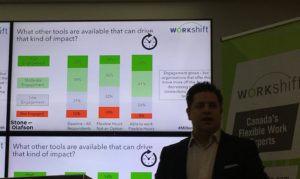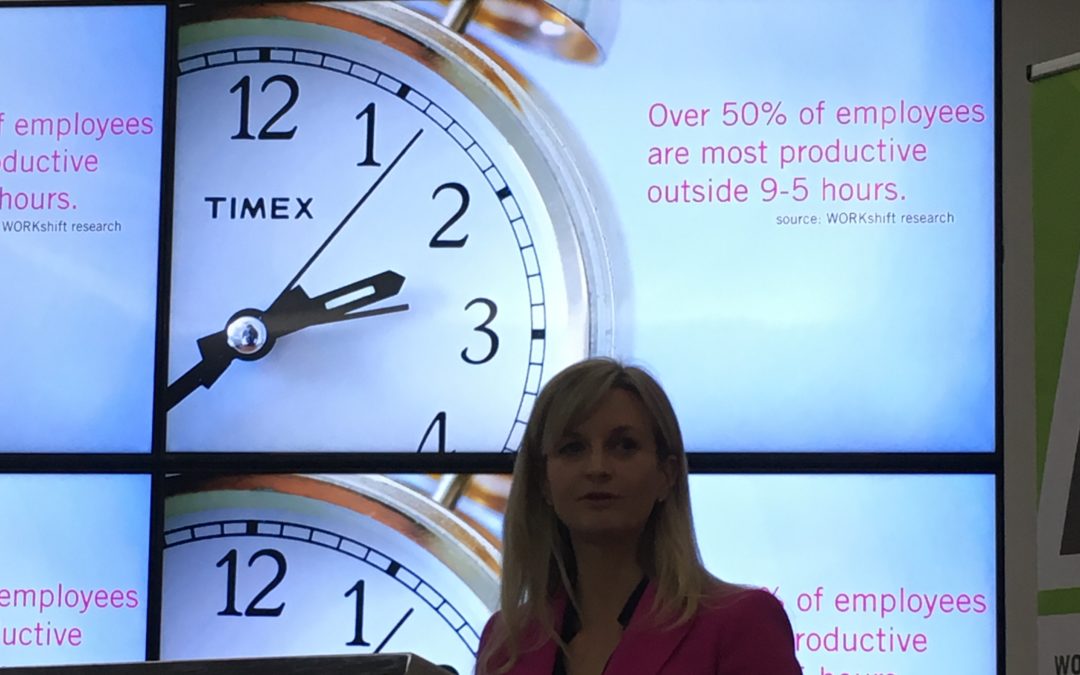I had the pleasure of attending an event hosted by Canada’s workplace flexibility experts, WORKshift, in Toronto earlier this week. WORKshift has recently partnered with Stone Olafson to do a Canadian study, investigating engagement, generational differences, and flexibility in the workplace. The study was conducted in June of 2016, and included 2000 employed people. The findings reveal some clear priorities for leaders who want to engage today’s workforce. Here are my top 5 take aways.
Scrap your Millennial Strategy
I was so thrilled to hear that the research this team conducted showed that there is no real difference between Millennials and Gen X-ers. So many companies are working on strategies to attract and engage Millennials. I often hear from leaders that this new generation is lazy, entitled and unrealistic in their aspirations. I disagree, because millennials have been some of the best workers I’ve had on my teams in the past. I’ve found them to be passionate, hard-working, and intelligent. Millennials are often starting their careers, and I think that lends itself to unrealistic aspirations. They don’t know any better yet. Millennials are coming from university and college environments where they decided when and where to do their homework and planned their semester schedules and classes to fit their life. When your work environment endorses an 8:30 to 5:30, in-your-seat mentality, it’s a little foreign to them. Perhaps people think this is lazy. In my mind, it’s just a shift in the way we think about work (and a good one to make).
In their study, WORKshift asked about satisfaction with a variety of workplace factors. They included communications, work-life balance, technology, training and more. They found that there was no difference in levels of satisfaction from Millennials to those in Generation X. Boomers seemed to have an average of 5% higher satisfaction with most factors. In essence, though, age or generation had little to do with engagement differences. The more meaningful elements were position or level in the organization, geography, and the size of the workplace. While 58% of Canadians were found to be moderately or highly engaged at work, here are some differences:
- 67% of those working at small companies were engaged
- Employees in the Maritimes, Quebec and Alberta were more likely to be engaged. Ontario had the lowest engagement numbers
- Those who were in leadership positions or self-employed are more likely to be engaged – 75% and 73% respectively, vs the average of 58%
Flexibility is key

Mathew Stone from Stone Olafson presenting data on Flexibility
If you’ve been following other posts by me, you know I strongly believe in greater levels of autonomy and accountability at work. I know how I get my best work done, and it is often not in a traditional office environment, and it is often after the hours of 9-5pm. I also know how much time so many leaders waste managing people’s time, rather than their performance and the results they achieve. When I hear leaders discussing the number of breaks someone takes, the times they’ve been late or left work early, or qualifying why they, but not their direct reports, can work from home, it is like nails on a chalkboard to me. It’s why I became certified in Results-Only Work Environment™ – the ultimate in flexible work. In a ROWE™, every employee is 100% accountable and 100% autonomous to determine how, when, and where to do their part to serve your ultimate customer and get great results.
The study found several important insights that support the need for a flexible work environment. First, more than 50% of employees are most productive outside the hours of 9-5. Think about that for a moment. That means that, in most workplaces, you are getting under-performance from a majority of your workers. Another insight form the study was that those who have the option of flexible work were more satisfied with a variety of workplace factors than the average, with 67% highly engaged vs the overall average of 58%. Almost half – 46% – of employees are willing to take a decrease in pay for a work environment with a lot of flexibility. If you want a productive and engaged workforce, increased flexibility is key.
Focus on meaningful work
We believe purpose and values are the foundation of effective leadership and high performance culture. We’ve written about this in our Blueprint for Workplace Reinvention and in various blog posts. In the work we do with organizations to improve or develop the culture they desire, we start with identifying a purpose greater than profitability. We’re living in a time when the workers who are connected to work via their smartphones are working an average of 72 hours per week (CCL, Always On). When we have less time for leisure, volunteering, and outside interests, we expect more from work. Making sure your employees know how they make a difference to your organization, your customers and the community is a huge step in the right direction.
The WORKshift study found that 88% of Canadians want work to be fulfilling. Seventy-three percent expect that their work should contribute to the world. They even found that 37% of employees would take less money if their work had a positive and direct impact on quality of life. When we work with organizations on purpose, we often find very corporate-sounding mission statements, like “we will be the best XYZ company in the world.” That’s not inspiring for your people. Think about what makes your service or product life-changing for people. What would happen if your company no longer existed? What would be missing in the world? How do you provide your service differently from competitors to add value? Is there an opportunity to use your profitability to make positive change in the community? Identifying these opportunities will help to engage your people with more meaningful work.
Values and Culture matter
Seeing data to support our focus on developing Values-driven leaders and organizations is awesome. I have experienced first-hand the uneasy feeling you have when your Values don’t match those of your organization. I see anecdotal evidence of this all the time as leaders struggle with decisions they aren’t aligned to, or with behaviour that doesn’t represent the Values hanging on the wall.
In this study, WORKshift found that 26% of employees said that their organization has a clear set of Values but doesn’t live them. Thirty-eight percent of people would take a drop in pay to work with an organization with Values aligned with their own. This is really where your organization can set itself apart from your competition. People have different Values, and so do organizations. You don’t need to copy some of the “best practices” from companies like Google or Zappos to win the Values game. Be genuine about what is important to you, and then weave your core Values into every process, practice and decision you make. When your leaders live the Values authentically, they inspire commitment and engagement in people.
Different strategies for different segments of your workforce
Finally, it’s important to consider different tactics for different segments of the workforce. The study found that there are 5 segments, based on how people think, how they see work, and their connections in and outside of work. The five segments are Cynics; Passives; Boosters; Intrapreneurs; and Detractors. The study does a great job at describing these segments and providing suggestions for what is needed to engage these groups differently.
I recommend you download the “Debunking the Millennial Myth” report from WORKshift and review the study results – there are lots of great insights and suggestions to help you determine how to truly engage your workforce.
If you’re ready to go ROWE™ or to get real about your organization’s Values and Culture, contact us!
CultureRx® is the owner of the Results-Only Work Environment™ and ROWE™ trademarks, copyrights and other intellectual property which identify the innovative management methodology. No direct or indirect use of the intellectual property, trademarked or copyrighted names, materials or any other aspects of ROWE™ may be used by consultants, or to describe any work environment without express written consent through certification by CultureRx®. Unauthorized use is prohibited.


Recent Comments